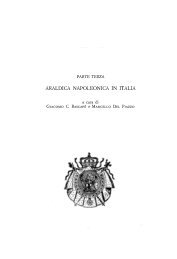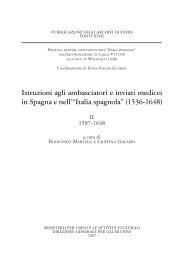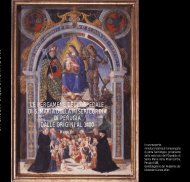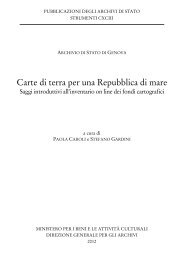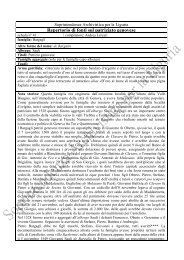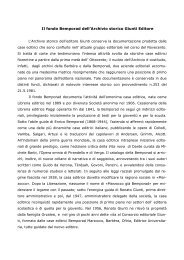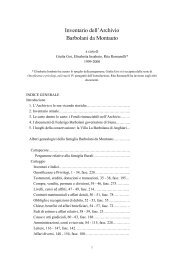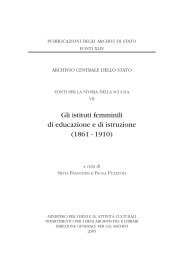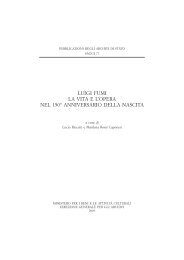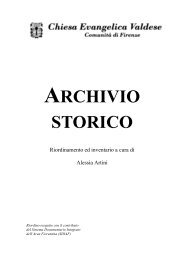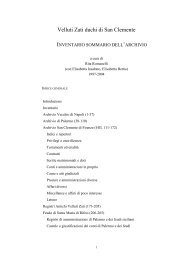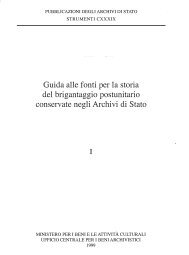esercito e città dall'unità agli anni trenta. tomo i - Sistema ...
esercito e città dall'unità agli anni trenta. tomo i - Sistema ...
esercito e città dall'unità agli anni trenta. tomo i - Sistema ...
Create successful ePaper yourself
Turn your PDF publications into a flip-book with our unique Google optimized e-Paper software.
486 JOHN A. DAVIS<br />
presence of soldiers and policemen, never mind the relations between them,<br />
in the cities of the Italian peninsula in these years remain all the more<br />
uncertain 5.<br />
In generai terms, however it is clear that over the course of the 19th<br />
century the business of urban policing became more specialised and<br />
developed clearer divisions of labour between the different civil and military<br />
agencies involved. As a result, the military's role in urban policing steadily<br />
diminished, although this did not happen in a uniform way nor did it cease<br />
altogether.<br />
One of the earliest indications of the importance of the role assigned<br />
to armies in urban policing dates back to the period of reform during the<br />
Napoleonic era. During these years the rulers of the major Italian satellite<br />
states embarked o n programmes of urban reconstruction and reorganization,<br />
and a common feature of these undertakings was the the construction of<br />
new roads, especially in the capi tal cities, to facilitate the movement of troops<br />
into the popular quarters of the cities in times of disturbance 6. Recognition<br />
that urban order depended ultimately on the presence of an army was<br />
not in itself an innovation, and there were few major Italian cities that were<br />
not dominated by some grim fortress or barracks that offered an unmistakeable<br />
reminder of the 'internai security' functions of the Ancien Regime<br />
armies. But like Hausmann' s reorganization of Paris later in the century, the<br />
creation of improved communications linking city centres with military garrisons<br />
by the Napoleonic rulers in Italy is evidence of the continuing recognition<br />
of that role and the priority that was placed on adapting older intensions<br />
to rapidly changing urban realities.<br />
N or can there be any doubt that the character of the Empire itself gave<br />
the army a new and centrai politica! importance which was again fully<br />
reflected in the Italian satellite states. Contemporary accounts (for example,<br />
De Nicola's Diario Napoletano) illustrate the prominence and frequency<br />
of military parades, which served the dual purpose of an imposing show<br />
of force which at the same time also transmitted the values and glories of<br />
the Empire and of the new dynasties that it nurtured in Italy.<br />
With the Restoration - and in particular after the revolutions of 1820-1<br />
in Naples an d Turin in which sections of the respective armies were heavily<br />
implicated- the army's role in the maintenance of public order and public<br />
security became more ambiguous, however. The spread of seditious ideas<br />
5 These wider issues are discussed in ]. A. DAVIS, Conflict and Contro!: Law and<br />
Order in Italy in the 19th Century, Macmillan 1988.<br />
6 Eg C. DE SETA, Napoli, (Le Città nella Storia d'Italia) Bari 1981, p. 214.<br />
THE ARMY AND PUBLIC ORDER IN ITALIAN CITIES 487<br />
and the successful expansion of secret societies amongst the officers of the<br />
different Italian armies, no t to menti o n the no t far distant examples of military<br />
pronunciamentos in Spain, caused the Italian rulers to look with suspicion<br />
and uncertainty on their armies. Many, like the rulers of the Kingdom of<br />
the Two Sicilies for example, turned to outside (i. e. Austrian) support or else<br />
employed foreign mercenaries for greater security.<br />
The same fears lay behind the attempts that were made in the 1820s<br />
and 1830s to raise para-military popular militias, the most famous being those<br />
which Prince Canosa create d for the Duke of Modena an d the Pope 7• But<br />
these initiatives were also part of longer term attempts to reduce the army's<br />
public order and public security duties. These can again be traced back to<br />
the Napoleonic period. The French regimes brought to Italy not only clear<br />
models of urban policing from metropolitan France but also an awareness<br />
that public security functions distracted armies from their proper military<br />
functions and made them military less effective. The creation of both civil<br />
policing agencies and of volunteer militias with specific public security functions<br />
was therefore seen as a matter of considerable importance First, the<br />
delegation of public security functions to separate bodies was necessary if<br />
the Italian armies were to meet their obligations to the Empire and serve<br />
in the Emperor's campaigns. Secondly, it was already being argued that the<br />
professionalization of the army as a fighting force made it desirable that it<br />
should disengage as far as possible from ordinary internai security functions,<br />
even thought its role in case of emergency or major break down of public<br />
order was never questioned 8 .<br />
It was symptomatic of these tendencies that the new urban and rural<br />
policing agencies that had been introduced during the French period were<br />
maintained - most obviously the Piedmontese Carabinieri that were<br />
established in 1814. But the Carabinieri and the Gendarmeries that were<br />
established in other states were seen primarily as rural policing agencies.<br />
Much less is known about the ways in which the major cities were policed<br />
in this period, although here too the French reforms had established clear<br />
distinctions between the spheres of military and civil jurisdiction and<br />
organization. In theory at least, urban policing became more bureaucratic,<br />
more professional and more specific. The broad Ancien Regime concept<br />
of policing that was synonymous with Buon Governo gave way to narrower<br />
7 On this see eg F. LEONI, Storia della Controrivoluzione in Italia 1789-1854, Napoli<br />
1979.<br />
s Eg L. ANTONELLI, I Prefetti dell 'Italia Napoleonica, Milano 1983, pp. 215-223,<br />
455-474.



